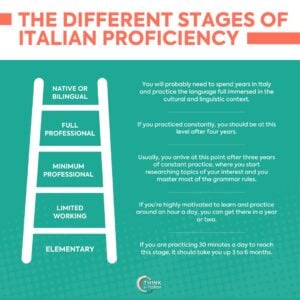When to use in?
Prepositions are words placed before a noun or pronoun to show their relation to the sentence and are often used to express spatial or temporal relations.
Simple prepositions (preposizioni semplici) are those that only have one single element and are not compounded with any other word.
When referring to a place or location, the preposition in is used in the following cases:
- When expressing direction (to) the place
- When referring to the location of something or someone
- For countries, regions, continents, big islands
Countries:
Sono andato in vacanza in Tailandia.
I went on vacation to Thailand.
Luca abita in Norvegia.
Luca lives in Norway.
Pechino è una città in Cina.
Beijing is a city in China.
Regions:
Firenze è in Toscana.
Florence is in Tuscany.
Domani torno in Lombardia.
I’m going back to Lombardia tomorrow.
Continents:
Big islands:
Giorgio ha una casa in Sicilia.
Giorgio has a house in Sicily.
- With the following places: banca (= bank) , biblioteca (= library), classe (= class), città (= city), chiesa (= church), campagna (= country), piscina (= pool), ufficio (= office), albergo (= hotel), farmacia (= pharmacy), etc.
Dopo la scuola di solito vado in biblioteca a studiare un paio d’ore.
After school, I usually go to the library to study for a couple of hours.
Practice with Quizlet
Here's a set of flashcards and quizzes to practice this grammar topic.When to use a?
In Italian, the present tense is used in the following cases:
- When expressing direction (to) the place
- When referring to the location of something or someone
- For the name of cities and small islands
Cities:
Lucia abita a Milano.
Lucia lives in Milan.
La prossima settimana mi trasferisco a Firenze.
Next week I’m moving to Florence.
Small islands:
Il Sig. Rossi ha aperto un ristorante a Malta.
Mr. Rossi opened a restaurant in Malta.
- With the following places: casa (= home/house), scuola (= school), teatro (=theater), etc.
Oggi non esco, resto a casa.
I’m not going out today; I’m staying home.
Prendi l’autobus per andare a scuola?
Do you take the bus to school?




















6 Responses
I placed C1 on your assessment. These rudimentary prepositions are a total mystery to me still. I just leave them out when communicating and it’s embarrassing to me. 🙁
This quizlet goes much further into prepositions than “a” and “in” as was explained in the grammar description. (good thing). Is it safe to assume that learning when to apply which preposition is best learned by rote repetition? Particularly for the places we go to not covered in the quiz? Hard rules just don’t apply across the board?
Ciao @virginia-ivy!
Italian prepositions often skip usage rules. I will leave you some guidelines down below but remember the only way to learn how to use them is by practicing.
Please let me know if you want examples for each of the prepositions.
DI indicates possession, material, argument, mode, and origin.
A indicates where the speaker is, where the speaker is directed, the person’s object of the action, and time.
DA indicates places, time, passive agents, and objectives.
IN indicates places, feelings, means of transport, and time.
CON indicates company and tools.
SU indicates position and argument.
PER indicates places, time, and cause.
TRA and FRA are synonyms and indicate position, alternative, relation, and time.
“Paese” e Stato” è più o meno uguale.
Hi Stefano,
A little confused. In the example above you say “Stati” to refer to countries, but wouldn’t countries be paesci?Quanti paesi ci sono in Asia? or can you use Stati interchangeably.
Thank you.